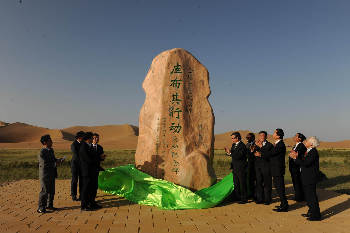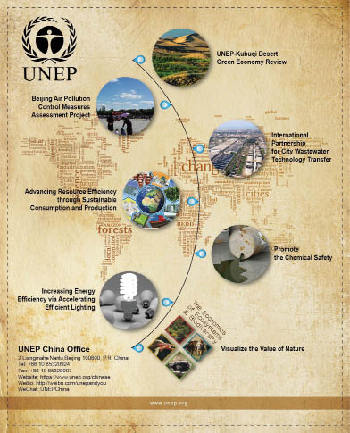By JIANG NANQING
ACCOMPANYING unprecedented economic growth, a booming population, industrialization, and urbanization over the last few decades, China faces mounting environmental pressure. Climate change, loss of biodiversity, desertification, and unsustainable use of land, as well as global issues like energy, food, and water scarcity, hinder the country from reaching its poverty alleviation and sustainable development target. Therefore, the environment is one of the key areas of cooperation between China and the UN.
The United Nations Environment Programme (UNEP), founded in 1972 with its headquarters in Nairobi, Kenya, is the leading global environmental agency within the UN. Prior to the first United Nations Environment Assembly (UNEA) held in 2014, the 58-member governing body was reformed to universal membership (to include the full 193 member states of the UN), reinforcing the status and role of the UNEP.
In September 2003, the UNEP opened a liaison country office in Beijing – one of a handful of its kind. This move highlighted China’s important status in dealing with global environmental issues, and promoted further cooperation between the UNEP and China.
|
|
|
Dr. Jiang Nanqing, the author, was judge at the youth contest “Solve for Tomorrow” in 2015. |
Close Cooperation
During the 18th National Congress of the Communist Party of China (CPC) in 2012, China vowed to give high priority to ecological progress and incorporating it into building a beautiful country. It hence set the goal of sustainable development in line with the global trend.
“China admits it needs to rethink the role of the environment and that of its environmental sustainability dimension in future economic development,” said Achim Steiner, executive director of the UNEP and under-secretary-general of the UN. He interpreted the notion of ecological progress in two respects: First, shifting to a green economy model doesn’t entail a totally different mode of development; second, the rising cost of pollution abatement is increasingly affecting economic development.
Since the Chinese government signaled the economic transformation, UNEP has propelled policymaking in such fields as the environment, climate change, and sci & tech through strategic partnership with the central and local governments. It also provided technical assistance to incorporating environmental issues into national strategy, facilitating implementation of a group of projects on issues from climate change, pollution abatement, and management of chemical materials, to resource efficiency, biodiversity and ecosystem protection, green economy, and South-South Cooperation.
Currently, the UNEP closely collaborates with the Ministry of Environmental Protection, National Development and Reform Commission, Ministry of Science and Technology, Ministry of Industry and Information Technology, and influential departments in other fields like the People’s Bank of China. It also conducts full-scale cooperation with the municipal governments of Beijing, Guiyang, and Tianjin, research organs like the Chinese Academy of Sciences and the National Natural Science Foundation of China, and of course, the private sector. The UNEP has co-founded or sponsored an array of projects like the UNEP-Tongji Institute of Environment for Sustainable Development in 2002, the UNEP International Ecosystem Management Partnership in 2011, and the Global Efficient Lighting Center in 2012. All have become UNEP resource centers in China.
As an implementing agency of the Global Environment Facility (GEF), the world’s largest public funder of environmental projects, the UNEP plays a key role in supporting countries to develop and execute GEF projects. In China, such projects cover a wide range of issues from climate change, biodiversity, and land deterioration, to trans-boundary waters and chemicals management.
The Chinese government is attaching increasing importance to high-level think tanks and their suggestions. UNEP Executive Director Achim Steiner serves as vice chairperson of the China Council for International Cooperation on Environment and Development (CCICED). He has offered advice on China’s 13th Five-year Plan and sustainable development strategy. Steiner believes that the environmental issue shouldn’t be segregated from other issues in China, as it is a systemic and long-term issue concerning economic development. As vice chairperson of the CCICED, he said he would assist international environmental specialists, Chinese experts and the government in discussing and researching China’s environmental and development issues. He hoped to help test current environment policies in China to see if they are on the right ecological development track.
 |
|
Achim Steiner attends the unveiling ceremony of the Kubuqi Action in Inner Mongolia which aims to fight desertification. |
China’s Green Economy
UNEP launched the Green Economy Initiative in 2008, calling on governments to increase investment in green industries to develop an economy featuring resource efficiency and social inclusion, which are precisely the targets of the Chinese government. Since 2009, UNEP and the Chinese government have jointly carried out research on the concept, investment, and indicator system of the green economy, and also the accounting system of the environmental protection industry. These studies objectively analyze the environment industry’s potential contribution to economic growth, and also help bring the industry into the national accounting system.
UNEP is involved in the Partnership for Action on Green Economy (PAGE) project, jointly launched by five UN organizations – UNEP, United Nations Development Program (UNDP), United Nations Industrial Development Organization (UNIDO), International Labor Organization (ILO), and United Nations Institute for Training and Research (UNITAR) – aiming to solve the problems of multiple facets of the green economy. Cooperation among UN organizations makes it possible to cover major elements of this issue, and provide a comprehensive set of services and tools for developing a green economic strategy for countries.
In China, PAGE has chosen Jiangsu as a pilot province. The research team held rounds of discussions with relevant departments about problems, challenges, and demands when developing a green economy, and also carried out field research in cities like Nanjing and Zhenjiang. In collaboration with the provincial government, it analyzed investment and supporting policies and drew up a blueprint for Jiangsu’s green development.
Sustainable energy is a key part of the green economy. When UN Secretary-General Ban Ki-moon launched “Sustainable Energy for All” (SE4ALL) in 2009, a series of platforms were established for accelerating the initiative in many fields, like district energy, building, transportation, lighting, and appliances. UNEP is actively engaged in two of the 11 action areas identified by SE4ALL – efficient lighting and vehicle fuel efficiency, and district energy. It is also taking responsibility for propelling it through the mode of public-private-partnership (PPP).
In 2012, the UNEP and China’s National Lighting Test Center co-established the Global Efficient Lighting Center (GELC). The center’s aim is to promote LED lighting and help set up related policies, standards, and quality inspection systems in African, Asian, and Pacific countries based on China’s experience and technologies. In November 2014, the Global Efficient Lighting Forum was held successfully in Beijing. UNEP also positively conferred with the Chinese government and industrial partners to realize a leapfrog in the high-efficient home appliances and equipment market, which covers a range of electrical appliances and also electric vehicles and IT products. The aim is to reduce electricity consumption and slow the rate of climate change.
As China is stimulating domestic demands, sustainable consumption and production naturally becomes one of the key cooperation areas with the UNEP. As the secretariat of the 10-Year Framework of Programs on Sustainable Consumption and Production Patterns (10YFP), the UNEP advocated the CCICED’s setting up of a research project on green consumption, and collaborated widely with Chinese cities, NGOs, and guilds to promote the concept. It has co-hosted China Sustainable Consumption Week annually since 2013.
|
|
|
Main areas of the UNEP’s work in China. |
South-South Cooperation
With fast economic growth, China is increasingly capable of helping other developing countries realize sustainable development through South-South Cooperation (SSC). “China and the World” has become a hot topic among offices of the UN system in China. SSC is one of the three key projects under the United Nations Development Assistance Framework in China. It also echoes the Belt and Road Initiatives recently put forward by the Chinese government.
Though faced with many environmental challenges, China has developed various low-cost, high-efficiency technologies and products, and accumulated experience in climate change mitigation and pollution abatement that fits other developing countries. It is expected that more Chinese cities, becoming aware of the environment’s influence, will devote funds and expertise to the international promotion of sustainable economic development. These are opportunities for SSC.
Emerging countries like China are taking a leading role in SSC, said Achim Steiner. The senior environmental expert pointed out that less developed countries are no longer looking to developed countries for direction; instead, they would like to cooperate with each other, so becoming a new model of SSC. From this perspective, Steiner said, China’s adoption of the path of green economy will profoundly influence the green economic transition across the world.
In 2012, the Chinese government contributed US $6 million to the UNEP’s Trust Fund to support developing countries in building their capacity for environment management. On this basis UNEP offers support on an international level, including finding the most suitable technologies for countries, establishing technology transfer schemes and partnerships, and recognizing challenges.
The International Partnership on City Waste Water Technology Transfer is the best example. This project inspected over 40 kinds of sewage processing operations in more than 20 Chinese cities over a year. It meanwhile analyzed the demands of African and other less developed countries, and eventually set up last April the Asian regional hub for Global Wastewater Initiative in Beijing. The platform helps the docking between resources and demand by giving full play to information and technology sharing, so promoting SSC in wastewater processing.
In 2014, UNEP published UNEP Country Cooperation Framework on China (2014–2017), encompassing five sections including background, situation analysis, cooperation strategies, implementation means, and coordination and management. The following issues were listed in order of priority: propel the green economy in China, improve its environment capability and awareness, and assist and push forward the SSC. The framework will lay a solid foundation for further cooperation between China and UNEP.



